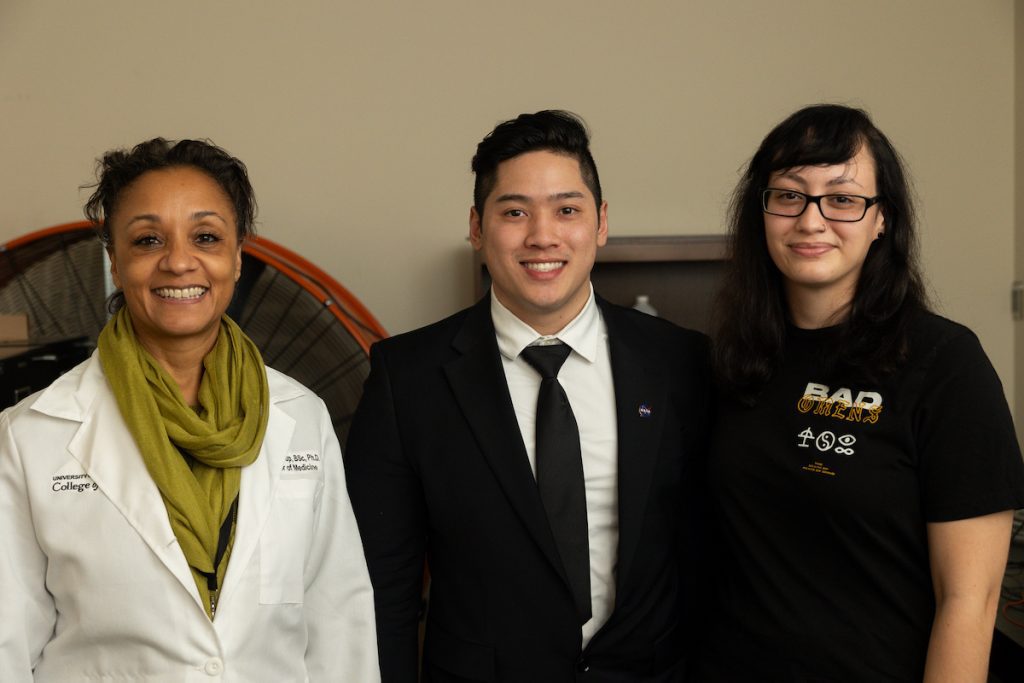
When the Blue Origin space flight blasted off on Tues, Dec. 19, it carried three UCF-led research studies aimed at keeping astronauts and equipment safe, including one that will help scientists better understand how space flight affects the bones.
UCF College of Medicine biomedical engineer Dr. Melanie Coathup is partnering with Dr. Michael Kinzel, an associate professor in UCF’s Department of Mechanical and Aerospace Engineering, to understand how the absence of gravity in space impacts the bones of space travelers.
“When you’re in microgravity, there’s a change in characteristics of fluid flow and we’re trying to find out if that includes the fluid flow in our bodies, particularly through our bones,” says Dr. Coathup, who heads UCF’s Biionix faculty cluster initiative, an interdisciplinary team developing innovative materials, processes and interfaces to support health and well-being.
Their study is among several dozen research payloads on the New Shepard’s 23rd mission, including three total from UCF. Dr. Adrienne Dove an associate professor in UCF’s Department of Physics, is collaborating with researchers at NASA Kennedy Research Center to examine how lunar dust behaves in microgravity, which can inform strategies to keep it from damaging people and equipment. Dr. Julia Brissett interim director of the Florida Space Institute (FSI) at UCF is examining how seismic waves and shaking can modify the surface and interior of an asteroid, which can give clues to the processes involved in their formation and evolution.
Microgravity-induced bone loss is a health risk for space travelers and long-term goals of human space exploration and colonization. NASA research has shown that astronauts who stay in space for extended periods can lose up to 1% to 2% of bone density per month, primarily in weight-bearing bones like the spine, hips and legs. That compares to bone loss of 0.5% to 1% per year in aging men and post-menopausal women on Earth. This significant bone loss can place space travelers at risk for bone fracture and an early-onset spaceflight-induced osteoporosis.

Dr. Coathup theorizes that while on Earth, gravity exerts a constant mechanical load to the skeletal system whenever we sit, walk or stand, which causes a tiny amount of fluid to flow in and out of bones.
“On Earth, when we bear weight on our bones, it forces fluid into the tissue and then as we take off the ground, water draws back out. So that applies a mechanical stimulus to our cells that sends nutrients into the bone and then removes waste products as well,” Dr. Coathup says.
“We predict that in microgravity, in the absence of weight-bearing, there’s very little fluid movement, which stops or reduces that mechanical stimulus that sends nutrients in and stops waste products from going out and we believe this may contribute to bone damage.”
This New Shepard mission does not have crew, but human subjects are highly complex and difficult to understand. So, the UCF researchers are combining medical and mechanical engineering technology to develop novel models that directly focus the study of human bone behavior to fluidic character in microgravity. Dr. Coathup is gathering the small-scale porous structure of bones using medical technology (CT Scans). These geometries are being used by Dr. Kinzel’s group to create a microfluidic chip to represent this geometry. These microfluidic chips are miniature flow channels that include artificial capillaries using advanced 3D printing technology. Fluid and tiny beads are pumped through the chip to mimic the proteins and solutes in blood. The goal is to develop comparisons of the flow in these bone-like chips in microgravity to the behavior in various orientations in normal gravity on Earth.
“We expect to see that the presence of gravity enhances micro-scale mixing needed to support healthy bones,” Dr. Kinzel says.
The experiment is not a perfect representation of a real bone, but rather a simplified model to help researchers understand mechanisms. The size of the beads and capillaries are much larger in the experiment than in people’s bodies.
“To accommodate this, we plan to use high-end computational modeling to scale down the experiment to a real human bone,” Dr. Kinzel says.
Dr. Kinzel, an expert in computational fluid dynamics, leads the team that is creating the microchip and its platform.
The overall study is led by imec, an international nano- and digital technology research organization. The study is primarily focused on demonstrating imec’s lens-free microscope technology in a space environment. UCF and imec collaborated to formulate research questions to demonstrate the added value of these new microscopes, which are both smaller and lighter than conventional ones, for future biological testing on the International Space Station.
Dr. Coathup has dedicated much of her research to figuring out how bones are impacted by aging and environmental stressors such as space flight, and is working on developing new technologies and therapies that can protect, repair or rebuild damaged bones.
Her collaboration with Dr. Kinzel is one of numerous payloads on this flight funded by NASA primarily through the NASA Flight Opportunities program. These payloads are helping researchers better understand the capabilities of living and working in space.